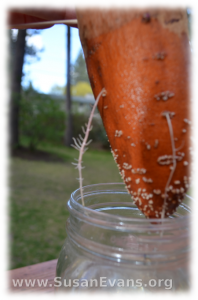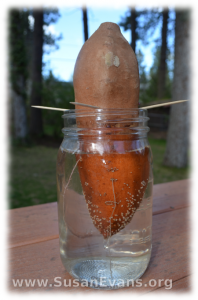Growing a sweet potato in water is a great way to see plant roots growing. You will need a sweet potato, a jar, water, and four toothpicks.
You will want to dip the sweet potato into the water about a third of the way down. Stab the toothpicks into the potato to keep it in place. Fill the jar with water. Now watch the roots grow right in front of your very eyes.
First you will see stubble, like a man who hasn’t shaved in a couple of days. This happens within the first few days. Then a few of the roots grow longer, branching out with root hairs. Since the jar is clear, you can see all this happening.
Other people buy expensive kits that have glass walls on either side so that you can see the roots of carrots and radishes growing, but the dirt is still in the way. With growing a sweet potato in water, you can see the root developing without any dirt in the way, and it doesn’t cost a lot.
 In biology this year, we studied the sections of a root, looking at the root under a microscope. The children were fascinated when they looked at prepared slides of monocot and dicot roots, which apparently have a different structure. Monocot roots have a circle shape in the middle, whereas dicots have an X shape.
In biology this year, we studied the sections of a root, looking at the root under a microscope. The children were fascinated when they looked at prepared slides of monocot and dicot roots, which apparently have a different structure. Monocot roots have a circle shape in the middle, whereas dicots have an X shape.
The main way to know if a plant is monocot or dicot is to look at its leaves. If the leaves are straight up and down like leaves of grass, it’s a monocot. If the leaf has veins branching out, it’s a dicot.
You can see all the other activities we did in biology this year in the Unit Study Treasure Vault.
Linked to Laugh and Learn
Tags: biology, Homeschooling, plants, roots, science




We’re currently doing this experiment. But I had no idea about the monocots and the dicots. You just kicked it up a notch. Thanks.
My kids enjoyed doing this experiment because they could see the roots growing little by little. It helped that we were studying biology at the same time!
What an awesome idea! I have a preschooler so we wouldn’t go too deeply into the different types of roots, but I think she’d love to see it start to grow. Thanks for sharing!
Oh, preschoolers love to see things grow! There’s magic in something that changes from day to day.
Neat experiment! This is JUST the type of thing Lorelai loves to do. She comes up with some question that must be answered and off she goes.
Thanks for joining the #laughlearnlinkup!
It was fun for my kids to see the roots growing longer every day.
Love it! So easy to do, and so much learning, too. #laughlearnlinkup.
Glad you liked it!
Susan, I wonder if you can grow sweet potatoes from one like this. I have always heard you have to order “slips” and it is a pricey and tenuous process. If it is as simple as developing roots, we’re so going to try to reproduce sweet potatoes 🙂
We did Apologia Botany last year (1st grade), so this brings back memories … monocots, dicots. As always, you do such good things with your kiddos.
I describe exactly what I did in this blog post, and I snapped this picture. I also remember doing this as a child, so you don’t have to buy “slips.”